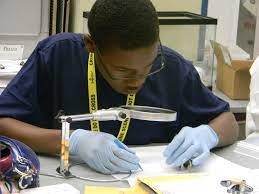Forensic Evidence in Murder Cases: The Science Behind the Scenes

Last Updated on March 9, 2024 by Ali Hamza
Modern murder cases rely heavily on forensic evidence because it may reveal important details about how a crime was committed. It offers a scientific perspective on the investigation and frequently aids in determining whether the accused is guilty or innocent. In this blog article, we will explore the various types of forensic evidence and the scientific methods employed in determining the truth as we dig into the world of forensic evidence and how a murder attorney in Charlotte works.
Forensic Evidence Types Used in Murder Cases
In murder cases, forensic evidence can take many distinct forms, each of which reveals something new about the incident. The following are some of the most typical forms of forensic evidence:
1. DNA analysis: DNA evidence is one of the most effective forensic science instruments. It might connect a suspect to a crime scene, a victim, or an object such as a weapon. DNA analysis was used to identify, match, or exclude certain individuals from the gathered evidence.
2. Fingerprint Analysis: Fingerprint evidence can be used to prove that a particular person is present at a crime scene. Identifications are made by experts by looking at ridge patterns, minute points, and other distinguishing characteristics.
3. Ballistics and Firearms Analysis: To identify whether a weapon used in a crime matches a bullet, cartridge case, or firearm, ballistics experts study these items. By doing so, the link between a suspect and a murder weapon can be proven.
4. Toxicology and Drug Analysis: Toxicology tests detect the presence of drugs, alcohol, or poisons in the victim’s body. This evidence is pivotal in cases of homicide, poisoning, or drugging.
5. Bloodstain Pattern Analysis: Bloodstain patterns can provide insights into the sequence of events during a murder. Experts examined the size, shape, and distribution of bloodstains to reconstruct crime scenes.
The Science Behind Forensic Evidence
Forensic evidence relies on a scientific approach to uncover the truth. The following are some key scientific methodologies used in forensic analyses:
1. Comparison and Matching: Comparison and matching are used in several types of forensic evidence. Analysts compare the evidence gathered at a crime scene with samples that have been previously identified, such as the suspect’s DNA or fingerprints.
2. Probability and Statistics: To determine how likely it is that the evidence was simply a coincidence, forensic professionals employ probability and statistical analysis. This establishes the credibility of the evidence presented in court.
3. Chain of Custody: In forensic science, a precise chain of custody maintenance is crucial. By preventing contamination or tampering, this guarantees the validity of the evidence
4. Experimental Design: To explore how various elements, such as bloodstain patterns or bullet trajectories, behave under various circumstances, scientists have built experiments that mimic crime scenes.
5. Quality Control and Accreditation: Forensic laboratories adhere to strict quality control measures and often seek accreditation to ensure that their practices meet the highest scientific standards.
Forensic evidence in murder cases is a testament to the intersection between science and justice. This can provide critical insights, establish connections, and determine the guilt or innocence of the accused. The scientific methodologies and technologies employed in forensic science continue to evolve, contributing to the pursuit of truth and justice even in the most complex murder cases.




